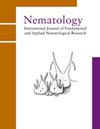On the phylogenetic status of Contortylenchus genitalicola Kosaka & Ogura, 1993
IF 1.2
4区 生物学
Q2 ZOOLOGY
引用次数: 0
Abstract
Contortylenchus genitalicola is a unique species within the genus. It parasitises the ovary or testis of the longhorn beetle, Monochamus alternatus, and has a neotylenchid-like culturable mycetophagous phase within its life cycle, while the other species in the genus parasitise bark beetles and have a typical unculturable allantonematid life cycle. Because the species was described based solely on morphology, it was necessary to confirm the phylogenetic and taxonomic status of C. genitalicola. A molecular phylogenetic analysis of the species based on ribosomal RNA sequences revealed that C. genitalicola forms a well-supported clade with Contortylenchus spp. isolated from bark beetles, an unidentified allantonematid from Iran, and ‘Deladenus cf. laricis’ isolated from the metallic wood-boring beetle, Agrilus macer LeConte (Coleoptera: Buprestidae), in the USA. The generic status of C. genitalicola was supported by phylogenetic analysis, and the analysis also suggests that the diversity of the genus could be higher than currently expected.生殖圆线虫Kosaka&Ogura,1993的系统发育状况
黄尾螺是属内的独特种。它寄生在长角甲虫(Monochamus alternatus)的卵巢或睾丸上,在其生命周期中有一个类似于新叶虫的可培养的噬菌期,而该属的其他物种寄生在树皮甲虫上,有一个典型的不可培养的异囊虫生命周期。由于该物种的描述仅基于形态,因此有必要确定其系统发育和分类地位。基于核蛋白体RNA序列的分子系统发育分析表明,C. genitalicola与从伊朗树皮甲虫中分离的Contortylenchus spp.和从美国金属蛀木甲虫Agrilus macer LeConte(鞘翅目:布氏科)分离的Deladenus cfl laricis形成了一个很好的支系。系统发育分析支持了该属的属地位,并表明该属的多样性可能高于目前的预期。
本文章由计算机程序翻译,如有差异,请以英文原文为准。
求助全文
约1分钟内获得全文
求助全文
来源期刊

Nematology
生物-动物学
CiteScore
2.60
自引率
33.30%
发文量
67
审稿时长
3 months
期刊介绍:
Nematology is an international journal for the publication of all aspects of nematological research (with the exception of vertebrate parasitology), from molecular biology to field studies. Papers on nematode parasites of arthropods, and on soil free-living nematodes, and on interactions of these and other organisms, are particularly welcome. Research on fresh water and marine nematodes is also considered when the observations are of more general interest.
Nematology publishes full research papers, short communications, Forum articles (which permit an author to express a view on current or fundamental subjects), perspectives on nematology, and reviews of books and other media.
 求助内容:
求助内容: 应助结果提醒方式:
应助结果提醒方式:


